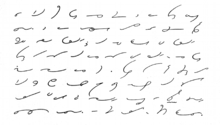
Back Gregga stenografio Esperanto Taquigrafía Gregg Spanish Greggin järjestelmä Finnish Sténographie Gregg French Notae greggianae Latin
| Gregg shorthand | |
|---|---|
 | |
| Script type | light-line semi-script alphabetic Stenography
|
| Creator | John Robert Gregg |
Time period | 1888–present |
| Languages | English, Afrikaans, Bahasa Indonesia, Bahasa Malaysia, Catalan, Esperanto, French, German, Hebrew, Irish, Italian, Japanese, Mandarin Chinese, Polish, Portuguese, Russian, Spanish, Thai, and Tagalog |
Gregg shorthand is a system of shorthand developed by John Robert Gregg in 1888. Distinguished by its phonemic basis, the system prioritizes the sounds of speech over traditional English spelling, enabling rapid writing by employing elliptical figures and lines that bisect them. Gregg shorthand's design facilitates smooth, cursive strokes without the angular outlines characteristic of earlier systems like Duployan shorthand, thereby enhancing writing-speed and legibility.
Over the years, Gregg shorthand has undergone several revisions, each aimed at simplifying the system and increasing its speed and efficiency. These versions range from the Pre-Anniversary editions to the more recent Centennial version, with each adaptation maintaining the core principles while introducing modifications to suit varying needs and preferences. Its efficiency, once mastered, allows for speeds upwards of 280 words per minute. The system is adaptable to both right- and left-handed writers.